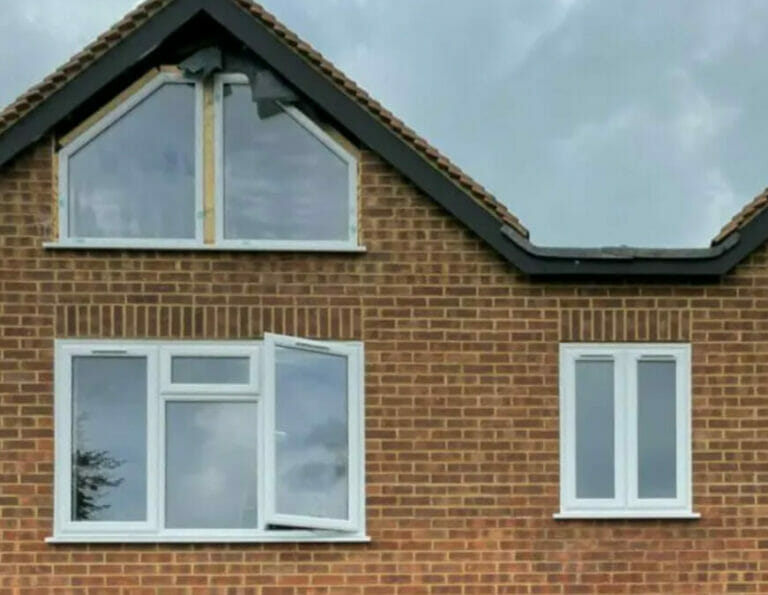Quick FAQs
[rank_math_rich_snippet id=”s-016cbf99-47cc-48c6-8026-7262aa481452″]
Non-equal sightlines and Equal sightlines are like yin and yang in the world of window design. One offers a consistent and uniform view, which is balanced and often symmetrical, while the other can offer a unique, dynamic look. In this article, we think about the benefits of creating deliberate non-equal sightlines and look at some examples of how they can transform the look of a property.
What Are Non-equal Sightlines?
Non-equal sightlines refer to the condition where the glass areas or frames of windows are different in size or shape. They are usually formed when one window features an opening, while others are fixed. The glass panels in the fixed windows will typically be larger than the others, making the overall sightline uneven.
Non-equal sightlines can be intentional or unintentional, and can have both positive and negative effects on the appearance and functionality of a building or room. When used deliberately, they can create interest. For some properties, an unequal sightline is very much part of the architectural style. This type of window design can be found in buildings such as art galleries or museums. It adds an element of surprise and intrigue, making it a perfect fit for spaces that want to make a bold statement.
On the other hand, equal sightlines are like a mirror, always reflecting the same image. This type of window design is perfect for office buildings or homes where clean lines, symmetry and a consistent view are essential. It’s a more practical and functional approach, and can be in keeping with the design of certain period properties.
Using Asymmetrical Windows to Create Non-Equal Sightlines
Some buildings use asymmetrical windows as a design feature. Asymmetrical windows can add visual interest and a unique character to a building, but they can also create an unbalanced appearance that some people may find unappealing.
Clerestory windows, which are windows set high in a wall allowing natural light to enter a room from above, can be arranged in an asymmetrical pattern to create a unique visual effect.
How Bay Windows Create Non-Equal Sightlines
Bay windows are a type of window that projects out from the wall, creating a larger glass area and a more prominent sightline. Bay windows can be designed in various asymmetrical shapes, such as trapezoids, triangles, or other irregular shapes.
While bay windows can add architectural interest and provide more natural light, they can also create a lopsided appearance if not properly balanced with other windows.
The Use of Entryway Windows to Create Non-Equal Sightlines
Another way to add interest to a property’s architecture is by using entryway windows around the front door. Sidelights and transom windows often offer unequal sightlines while adding character to the views and light in the property’s entrance.
How Fanlights Create a Non-equal Sightline
Fanlights, also called transom windows, are designed to create a separate sightline above the main window. The shape and size of the glass panes deliberately differ from the panels below, and even the thickness of the frame might differ. Available in many shapes and sizes, they can add to the room’s architectural appeal.
Corner Windows as an Example of Non-equal Sightlines
Corner windows are designed to wrap around the corner of a building, providing a panoramic view of the surrounding landscape. Asymmetrical corner windows can be used to create a more dynamic and interesting shape.
Tilt and Turn Windows
Tilt and turn windows can give the appearance of unequal sightlines, as they can be opened in different directions. They can offer a practical and modern dimension to homes, creating interesting lines.
What are the Disadvantages of Non-Equal Sightlines?
Sometimes non-equal sightlines may appear unbalanced and distract from the overall harmony of a property’s design. They’re not to everyone’s taste and won’t suit all properties. There may also be practicality issues to consider with some window designs offering non-equal sightlines. For example, transom windows, such as fanlights, are typically inoperable; they primarily serve to let in additional light.
Non-Equal Sightlines in Summary
In summary, non-equal sightlines can have both positive and negative effects on the appearance and functionality of a building or room. They can be intentional design features or unintentional, which may negatively impact the aesthetics of a property. Understanding the effects of non-equal sightlines can help you make more informed decisions about window design and placement.
Ultimately, it’s all about finding the right balance between aesthetics and functionality. So, don’t be afraid to think outside the box and go for something different. After all, life’s too short to blend in with the crowd.
Need to discuss non-equal and unique window designs?
Ultimately, it’s all about finding the right balance between aesthetics and functionality. So, don’t be afraid to think outside the box and go for something different. After all, life’s too short to blend in with the crowd.

